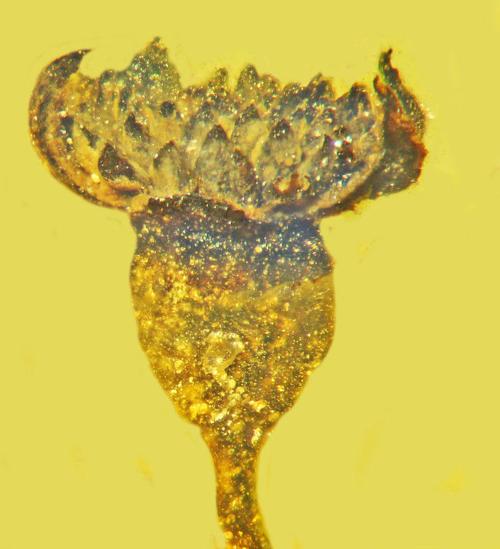
Here is a detail shot of the amber-encased flower that was identified by Oregon State University professors and other researchers.
An Oregon State University scientist famed for his work with specimens in amber, has come up with a new discovery.
George Poinar, Jr., whose work uses the same technology displayed in the novel and movie “Jurassic Park,” has identified a new genus and species of flower that is approximately 100 million years old.
“This isn’t quite a Christmas flower but it is a beauty, especially considering it was part of a forest that existed 100 million years ago,” said Poinar, professor emeritus in the OSU College of Science.
Poinar and collaborators at OSU and the U.S. Department of Agriculture named the new flower Valviloculus pleristaminis. Valva is the Latin term for the leaf on a folding door, loculus means compartment, plerus refers to many, and staminis reflects the flower’s dozens of male sex organs.
The flower became encased in amber on the ancient supercontinent of Gondwana and rafted on a continental plate some 4,000 miles across the ocean from Australia to Southeast Asia, Poinar said.
Geologists have been debating just when this chunk of land, known as the West Burma Block, broke away from Gondwana. Some believe it was 200 million years ago. Others claim it was closer to 500 million years ago.
Numerous angiosperm flowers have been discovered in Burmese amber, the majority of which have been described by Poinar and Oregon State uUniversity colleague, Kenton Chambers, who also collaborated on this research. Also working with Poinar on the new flower was Fernando Vega of the USDA and OSU’s Urszula Iwaniec.
The research was published in the Journal of the Botanical Research Institute of Texas.
“The male flower is tiny, about 2 millimeters across, but it has some 50 stamens arranged like a spiral, with anthers pointing toward the sky,” said Poinar, an international expert in using plant and animal life forms preserved in amber to learn more about the biology and ecology of the distant past.
“Despite being so small, the detail still remaining is amazing,” Poinar said. “Our specimen was probably part of a cluster on the plant that contained many similar flowers, some possibly female.”
The new discovery has an egg-shaped, hollow floral cup — the part of the flower from which the stamens emanate; an outer layer consisting of six petal-like components known as tepals; and two-chamber anthers, with pollen sacs that split open via laterally hinged valves.
The process of identifying a new species is laborious, Poinar said.
“The first thing I do is to take clear photos of the various parts of the flower,” he said. “This is done after I reshape and then polish the amber. Then there is a lengthy literature review when the various fossil characters are compared with those of known recent and extinct flowers. Many of these 100 million year-old flowers have such unique features that they cannot be placed in modern plant families.”
January 08, 2021 at 10:38AM
https://democratherald.com/news/local/osu-prof-discovers-new-flower/article_bff4a16c-57ac-5956-b951-acfa7014dd04.html
OSU prof discovers new flower - Albany Democrat Herald
https://news.google.com/search?q=Flower&hl=en-US&gl=US&ceid=US:en

No comments:
Post a Comment